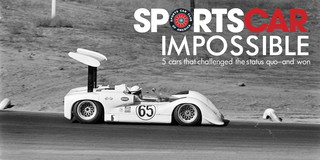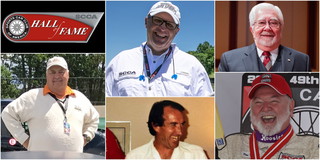
This article first appeared in the July, 2017 edition of SportsCar Magazine. SCCA members can read the current and past editions of SportCar digitally here after logging into their account; To become an SCCA member and get SportsCar mailed to your home address monthly in addition to the digital editions, click here.
They Can’t Do That...Can They?
Five cars that challenged the status quo in SCCA road racing competition – and won
In any class of racing, the choice of cars tends to settle down very quickly. Drivers and teams know what’s competitive and how to develop the competitive models to their best potential. At least, that’s the conventional wisdom. But every once in a while, someone turns the accepted truth on its head with an entirely new idea that wins races and shakes classes.
New designs that win are often rewarded with dramatic handicaps and some have even been banned from racing. But each of the cars listed in this story has made an impact on both SCCA racing and, in some cases, international motorsports; some revitalized their classes while others made entire fleets of racecars obsolete. But there’s a lesson in these stories: If you want to win, read the rulebook without any preconceived ideas of how things have to be done or what cars to use, and then build the best car you can.
World Changing: Chaparral in Can-Am
The Canadian-American Challenge Cup, better known as Can-Am, was developed in the mid-1960s as a North American series for FIA Group 7 sports racers. The rules were simple – the car had to meet basic safety rules, it had to have two seats, and the fenders had to cover the wheels. Other than that, it was run what you brung. Builders flocked to the series and produced some of the greatest racecars in history. Because of the open rule set, innovation was generally encouraged. But there was one notable exception.
Hap Sharp and Jim Hall had been building racecars since 1962 as Chaparral Cars Inc. Their Chaparral 2 design was a mid-engine car with a semi-monocoque chassis made of fiberglass. The car was successful from the beginning. Hall put the Chaparral on the pole at its first outing in 1963 and opened a huge lead before a mechanical failure took him out of the race. Hall went on to win the USRRC championship in 1964 handily, scoring seven victories, six second-place finishes, and a pair of third-place showings in 25 races. He repeated the performance in 1965, claiming 16 wins in 21 races, and he won the 12 Hours of Sebring that year.
Chaparral cars were always innovative, but among the most important inventions was the 1966 Chaparral 2E, which featured a cockpit-adjustable wing mounted directly on the rear suspension and extending several feet up into the airstream. The driver could trim the wing to adjust downforce by stepping on a pedal. Reduced downforce on the straights increased top speed, and then full downforce could be applied in cornering. Front-mounted aerodynamic elements were also controlled with the pedal. Hall’s innovation became popular in Can-Am and Formula 1 before suspension-mounted and cockpit-adjustable aerodynamic devices were banned by the FIA.
The most legendary of Hall’s creations was the 1970 Chaparral 2J “Sucker Car,” which famously used ground skirts and two large fans powered by a separate two-cylinder engine to create vacuum under the car. The fans were capable of creating up to 1.5g of downforce at any speed. The 2J was faster than anything else in the series, and was quickly banned from Can-Am after complaints from other teams.
While the Chaparral designs were ultimately banned, they pointed the way for aerodynamic development on every purpose-built racecar that followed.
Redefining: Swift DB1 in Formula F
In the early 1980s, many formula car designers were experimenting with moving the main suspension components out of the airstream and into the bodywork. For the 1982 season, cars like the Reynard FF82, Lola T640, Van Diemen RF82, Crossle 50F, Royale RP33, and the Viking all showed up with front suspensions that seemed to be made of slender rods hardly capable of supporting a racecar.
Each of those cars used the front suspension as a lever against a spring and shock absorber assembly mounted above or in front of the pedal box. That design moved the bulky coilover assembly out of the airflow. In a low-power class like Formula F, that difference created a huge advantage. Bob Lobenberg drove the inboard suspension Viking, designed by Arnie Loyning and Bob Erickson in Oregon, to the 1982 FF championship.
But the real revolution came in 1983 with the first racecar developed by Swift Engineering. The new Swift DB1 featured an aerodynamically optimized body and an entirely inboard suspension. The DB1 had the least aerodynamic drag of any FF ever made to that point. The car was introduced by R.K. Smith at the 1983 SCCA Runoffs and claimed the championship that year. Instantly, all older Formula F designs were rendered obsolete.
Over the next 13 years, drivers using the Swift DB1 claimed 10 championships in Formula F. Bruce May was the last driver to win with the DB1 in 1995 and ’96. The closely related Swift DB6 then won six more championships in the next 12 years, concluding with Chris Keller’s win in 2008. Swift Engineering built on the success of the DB1 to then create game-changing designs in Formula Atlantic and CART.
Banned: Audi Quattro in Trans-Am
In the 1980s, SCCA’s Trans Am series moved away from the original pony car formula to a more general Grand Touring format that included Japanese and European cars as well as the traditional domestic entries. The series used a weight-to-displacement formula to accommodate a wide variety of cars from Porsches to Nissans and, for one year, the Audi 200.
In 1988, Bob Tullius and Group 44 Racing fielded multiple Audis throughout the season, driven by Hurley Haywood, Hans-Joachim Stuck, and Walter Röhrl. The cars were powered by a turbocharged 2.2-liter, five-cylinder engine and used Audi’s quattro all-wheel-drive system.
Haywood won the championship that year, winning two races, claiming second place three times, and picking up a third-place finish as well. But that doesn’t tell the whole story. Stuck won four races and finished second once, and Röhr won two more races. In all, the Audi team won eight out of 13 races that season, easily securing the manufacturer’s title. Haywood took the championship with consistency, making every race, while Stuck skipped several events and suffered three DNFs. Röhrl competed in only six events.
By the end of the season, Audi had made the decision to switch to IMSA racing for 1989. Trans Am, meanwhile, decided to limit future competition to American-made engines and also banned all-wheel drive from the series entirely. It would be some time before all-wheel drive found its way back into SCCA racing, but Group 44’s dominating performance showed the competition the potential of such a technology.
Revolutionary: Stohr in Sports Racing
Revolutionary designs don’t always get banned; sometimes they change and revitalize a class. Before Lee Stohr developed his DSR in 2001, the class was largely populated with individually developed cars or models that had been designed decades before. Stohr noted that motorcycle engines were making far more power than they had previously, and he started to read the DSR rules very closely.
“One of the attractions of the DSR class was the lack of rules,” Stohr recalls. “For a designer, it was like the old days of the Can-Am. In DSR there was a maximum engine size, the tires had to be covered by bodywork, and that's about it. At the 2000 SCCA Runoffs, I penned a sketch of my proposed DSR in the men's bathroom, and before I knew it, I had five cash deposits!”
Stohr used oven-cured pre-preg fiberglass to keep weight down, and mounted a motorcycle engine as a partially stressed chassis element. He also doubled the front suspension travel to get the handling he wanted. After some development, the Stohr DSR fundamentally reshaped the sports racing category and paved the way for some of the fastest cars in SCCA history.
“I delivered the first two cars to customers at the 2001 SCCA Runoffs with no testing whatsoever, and that was a disaster,” Stohr admits. “But in 2002, we built a car for Mark Jaremko and, with his help, we got it sorted out well enough to take our first Runoffs National Championship. We’re still going, with 18 titles as of 2016.”
The Impossible: open top unibody in GT-Lite
Since its inception, the GT category has been the domain of fixed-roof cars, and over time, the category migrated to tube-frame silhouettes of the original cars. Since then, it seemed impossible that a unibody production car would win again in a GT class – until Kent Prather built a unique Miata and proved that assumption false.
“When they combined GT4 and GT5 into GT-Lite, they were kind of searching for cars,” Prather says. “So they put the Miata in the class, and I thought that as a tuner, I wanted to go with that. It seemed to me that the roadster would always have a better aerodynamic package than a tin top.”
Prather started work on his car in 2009, running in GT-Lite while his son Jesse ran the same car in E Production. In 2010, Kent Prather drove the car to a third-place finish in GT-Lite at the Runoffs.
“I had some issues because the wing couldn’t be as high,” Prather reveals, “but the Miata didn’t need a big wing. I was able to do a bunch of work in the fender wells and underneath the car. It was a struggle, though.”
But in 2011, Prather found the right formula. “I built a full GT-Lite engine with more compression and won the class in 2011 and 2012,” he says. “The car proved that it could win.”
In large part, Prather believes that reading the rulebook carefully and looking for ways to maximize your car’s potential is an important key to success. “When the rulebook says that the car has to stall in four seconds [when the single inlet restrictor is blocked], I make sure that my air box is big enough that it stalls in three or three and a half seconds,” he explains, “but I’d see guys where the car would stall immediately. I figured those guys didn’t take the time to build their air boxes properly.”
By taking a good look at the class and identifying an opportunity that no one else had noticed, Prather helped himself to two consecutive championships.
“GT cars have a lot going for them in brakes and chassis,” he says, “but in the aerodynamics, I don’t think they do. That’s what I worked on. It was a lot of fun and I’m glad I did it.”
Article by Jeff Zurschmeide










